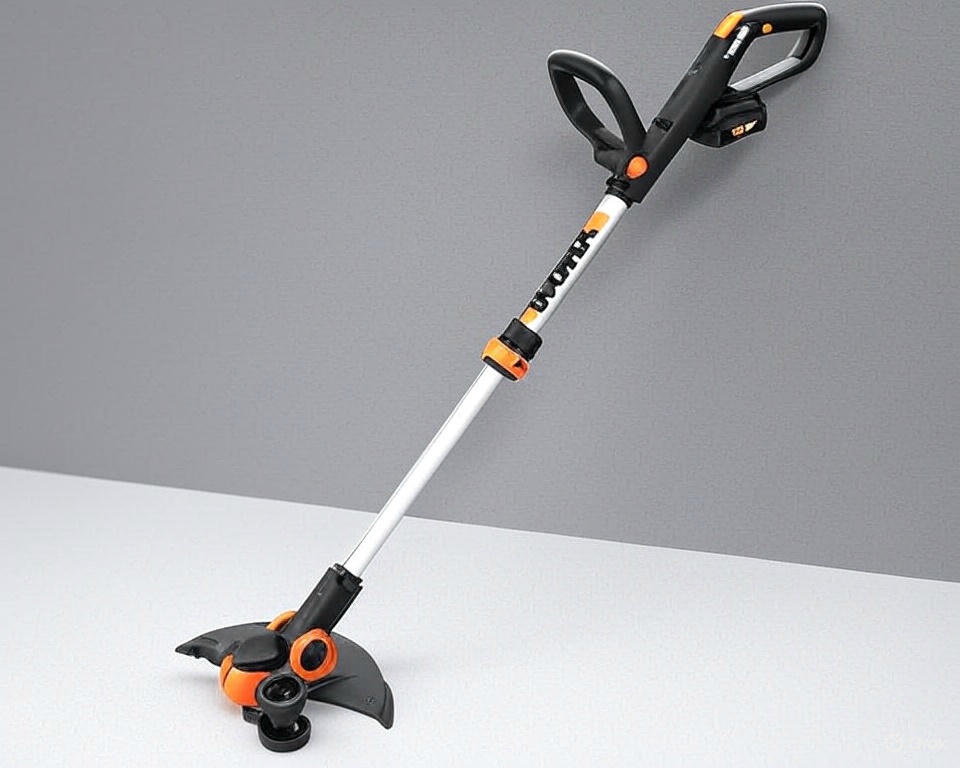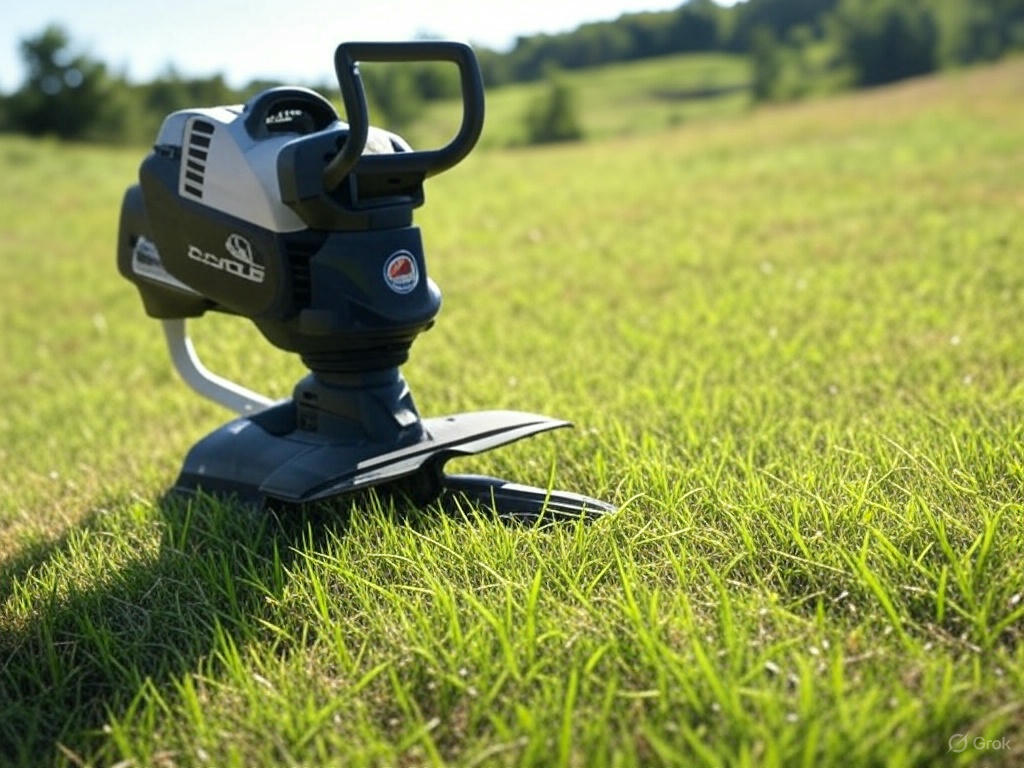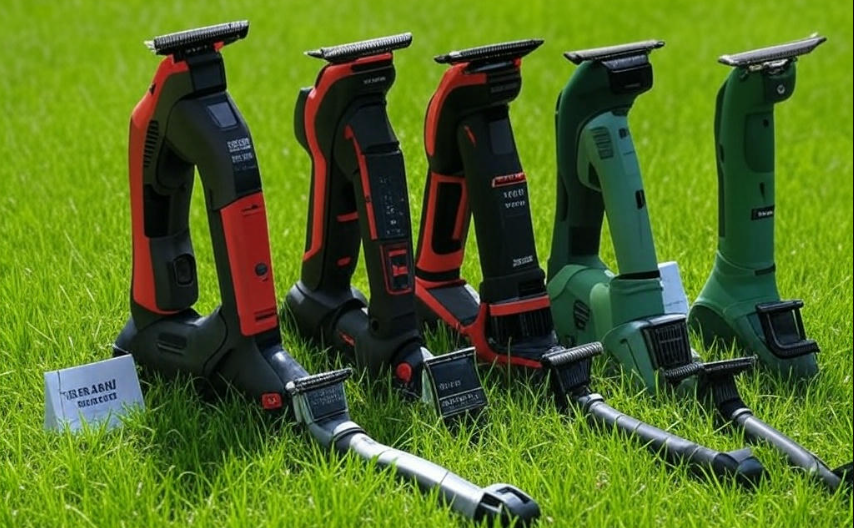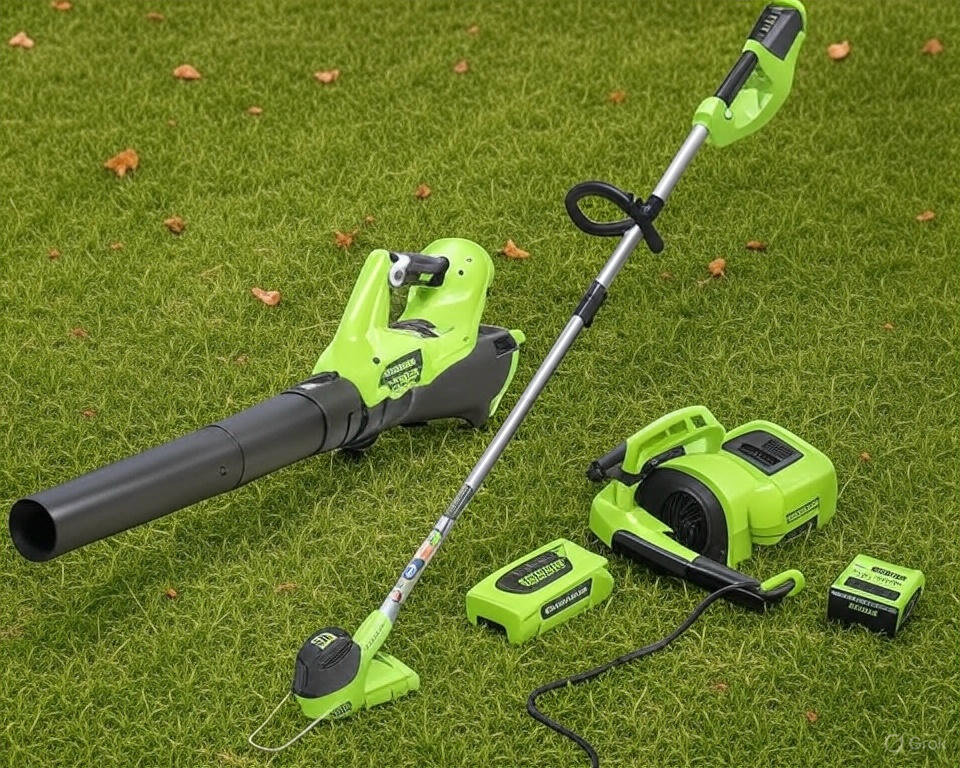Professional landscapers and property maintenance crews understand that choosing the right commercial grass trimmer can make the difference between efficient, profitable work and frustrating equipment failures. The commercial trimmer market offers a diverse range of options, from battery-powered cordless models to powerful gas-powered workhorses. Each type brings unique advantages to different commercial applications.
Commercial grass trimmers serve as the backbone of professional landscape maintenance operations. Unlike residential models, commercial-grade trimmers must withstand daily use, tackle challenging vegetation, and deliver consistent performance across extended work periods. These professional tools combine durability, power, and ergonomic design to help crews maintain client properties efficiently.
The landscape maintenance industry has witnessed significant technological advances in recent years. Battery technology improvements have made cordless trimmers viable for commercial applications, while gas-powered models continue to evolve with cleaner-burning engines and enhanced user comfort features. Smart features like automatic line feeding and variable speed control now appear across multiple price points.
This comprehensive review examines five standout commercial grass trimmers that represent the current market’s best offerings. Each model targets different commercial needs, from small property maintenance to large-scale landscaping operations. Understanding these differences helps business owners and crew leaders select equipment that maximizes productivity while minimizing operational costs.
Contents
- Understanding Commercial Grass Trimmer Requirements
- Key Features That Define Commercial-Grade Performance
- Battery-Powered Commercial Trimmers: The New Standard
- Gas-Powered Commercial Trimmers: Proven Performance
- Top 5 Commercial Grass Trimmers: Detailed Reviews
- Commercial Application Considerations
- Maintenance and Operating Cost Analysis
- Safety Considerations for Commercial Use
- Technology Trends Shaping Commercial Trimmers
- Buying Guide for Commercial Operations
- Professional Maintenance Best Practices
- Conclusion: Selecting Your Commercial Grass Trimmer
Understanding Commercial Grass Trimmer Requirements
Commercial grass trimmers face demands that far exceed typical homeowner usage patterns. Professional crews operate these tools for multiple hours daily, often in challenging conditions including thick weeds, overgrown areas, and varying terrain types. Commercial applications require trimmers that start reliably, maintain consistent power output, and resist wear from continuous operation.
Durability becomes paramount in commercial settings where equipment downtime translates directly to lost revenue. Professional-grade trimmers incorporate reinforced components, heavy-duty cutting heads, and robust housing materials designed to withstand impacts and environmental exposure. Commercial models typically feature user-replaceable parts and straightforward maintenance procedures to minimize service interruptions.
Ergonomic considerations play a crucial role in commercial trimmer selection. Professional operators spend extended periods using these tools, making comfort features essential for productivity and worker health. Balanced weight distribution, anti-vibration systems, and adjustable handles reduce operator fatigue while preventing repetitive stress injuries.
Power requirements vary significantly across commercial applications. Large property maintenance demands high-output trimmers capable of cutting through dense vegetation quickly. Precision work around landscaping features requires variable speed control and manageable power delivery. Understanding these operational requirements guides proper equipment selection for specific commercial needs.
Key Features That Define Commercial-Grade Performance
Commercial grass trimmers distinguish themselves through several critical performance characteristics. Engine displacement or battery capacity directly impacts cutting power and operational runtime. Commercial-grade engines typically range from 25cc to 50cc in gas models, while battery systems employ high-capacity lithium-ion cells with voltage ratings from 40V to 80V.
Cutting width determines work efficiency, with commercial models offering swaths from 12 inches to 18 inches. Wider cutting paths reduce the number of passes required to complete trimming tasks, directly improving productivity. However, wider heads may sacrifice maneuverability in tight spaces, requiring operators to balance efficiency against precision requirements.
String feeding mechanisms significantly impact operational efficiency. Manual bump-feed systems require operators to tap the head against surfaces to advance new string, while automatic systems monitor string length and feed new material as needed. Professional applications benefit from consistent string length maintenance, making advanced feeding systems valuable productivity features.
Handle configurations affect operator comfort and control during extended use. Straight-shaft trimmers provide better reach and balance for most commercial applications, while curved-shaft models offer enhanced maneuverability in confined spaces. Multi-position handles accommodate different operator heights and working angles, reducing fatigue during long work sessions.
Battery-Powered Commercial Trimmers: The New Standard
Battery technology advances have revolutionized commercial grass trimmer capabilities. Modern lithium-ion systems deliver power levels that rival gas engines while eliminating fuel mixing, exhaust emissions, and noise restrictions. Commercial battery trimmers now offer runtime capabilities suitable for full-day operations when paired with multiple battery packs.
Charging infrastructure considerations impact battery trimmer viability in commercial settings. Fast-charging systems reduce downtime between battery swaps, while standardized battery platforms allow crews to share power packs across multiple tools. Commercial operations benefit from battery systems that support hot-swapping, enabling continuous operation without work interruptions.
Maintenance advantages make battery trimmers attractive for commercial fleets. These systems eliminate carburetor adjustments, spark plug replacements, and air filter cleaning while reducing overall maintenance costs. Battery trimmers also start instantly and operate at consistent power levels throughout the discharge cycle, improving work predictability.
Weight distribution in battery trimmers affects operator comfort during extended use. Well-designed models balance battery weight against the cutting head to minimize operator fatigue. Some manufacturers offer backpack battery systems for heavy-duty applications, transferring weight from the tool to the operator’s torso for improved balance.
Gas-Powered Commercial Trimmers: Proven Performance
Gas-powered trimmers continue to dominate heavy-duty commercial applications where maximum power and extended runtime are essential. Two-stroke engines deliver exceptional power-to-weight ratios while providing the torque necessary to cut through dense vegetation and woody stems. These systems offer unlimited runtime with quick refueling capabilities.
Modern gas trimmers incorporate emission control technologies that reduce environmental impact while maintaining performance. Catalytic converters and improved combustion chamber designs lower exhaust emissions without sacrificing power output. Fuel-efficient engines reduce operating costs while meeting increasingly stringent environmental regulations.
Starting systems in commercial gas trimmers have evolved to improve reliability and reduce operator effort. Electronic ignition systems provide consistent spark delivery, while primer bulbs and choke controls simplify cold-start procedures. Some models feature spring-assisted starting systems that reduce pull cord effort for easier engine starts.
Vibration control in gas trimmers directly impacts operator comfort and long-term health. Anti-vibration systems isolate engine movement from operator handles using springs, rubber mounts, and balance weights. Professional-grade models incorporate multiple isolation points to minimize hand and arm fatigue during extended operation periods.
Top 5 Commercial Grass Trimmers: Detailed Reviews
1. EGO POWER+ String Trimmer ST1623T: Revolutionary Battery Technology
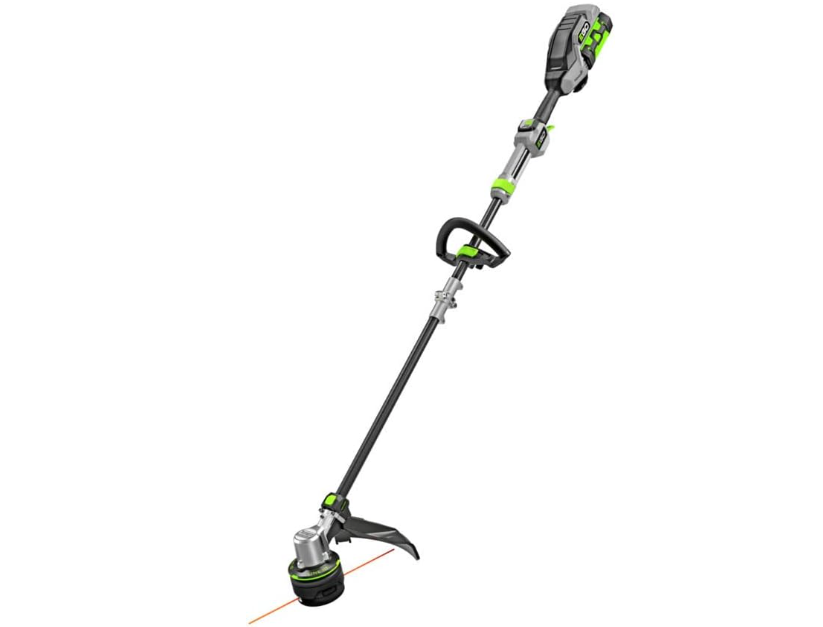
The EGO POWER+ ST1623T represents the pinnacle of battery-powered commercial trimmer technology. This innovative tool combines a 56-volt lithium-ion battery system with advanced LINE IQ technology that automatically monitors and adjusts string length for optimal cutting performance. The Ego Powerload with Line IQ is a top-notch trimmer that will likely exceed all of your string trimming expectations, making it an excellent choice for professional applications.
The 16-inch cutting swath maximizes productivity while the telescopic carbon fiber shaft adjusts from 59 to 70 inches to accommodate operators of different heights. The carbon fiber construction reduces overall weight while maintaining structural integrity under commercial use conditions. The POWERLOAD technology eliminates traditional string loading frustrations by allowing operators to simply push pre-cut string lengths through the head until they click into place.
Battery performance stands out as a key commercial advantage. The included 4.0Ah battery provides up to 60 minutes of runtime under normal conditions, while the rapid charging system restores full capacity in just 80 minutes with the standard charger. Charges in 30 minutes with an EGO POWER+ rapid charger, enabling minimal downtime between work sessions.
The variable speed trigger allows operators to match power output to cutting requirements, preserving battery life during light trimming while delivering full power for dense vegetation. The brushless motor technology eliminates maintenance requirements while providing consistent power delivery throughout the battery discharge cycle. Weather-resistant construction ensures reliable operation in challenging outdoor conditions.
Professional crews appreciate the instant-start capability and quiet operation that allows work in noise-sensitive areas. The balanced design reduces operator fatigue during extended use sessions, while the comfortable grip handles minimize hand stress. The EGO POWER+ platform compatibility allows crews to standardize on a single battery system across multiple tools.
Specifications:
- Battery: 56V 4.0Ah lithium-ion
- Cutting Width: 16 inches
- Shaft Type: Telescopic carbon fiber (59-70 inches)
- Weight: 11.2 pounds (with battery)
- Runtime: Up to 60 minutes
- Charge Time: 80 minutes (standard), 30 minutes (rapid)
- Features: LINE IQ, POWERLOAD, variable speed trigger
Pros:
- Automatic string length adjustment
- No-hassle string loading system
- Powerful brushless motor
- Adjustable shaft length
- Quick charging capability
- Platform battery compatibility
Cons:
- Higher initial cost than gas alternatives
- Limited runtime requires backup batteries
- Carbon fiber shaft may be vulnerable to impacts
2. Worx GT3.0 String Trimmer WG163: Versatile Cordless Performance
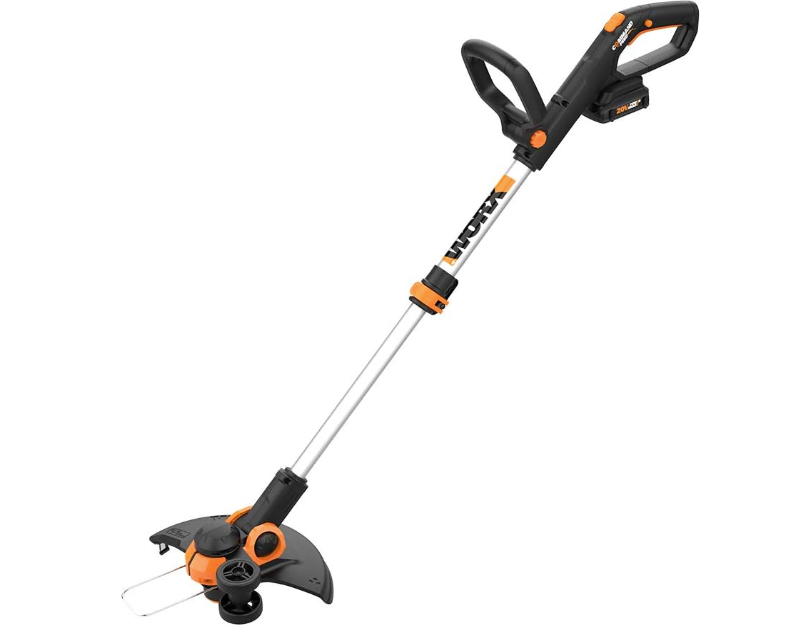
The Worx GT3.0 WG163 delivers exceptional versatility in a compact, lightweight package that suits commercial applications requiring maneuverability and precision. This 20V PowerShare system combines string trimming and edging capabilities in a single tool, reducing equipment inventory requirements for professional crews. The included dual battery system ensures extended operational capability without interruption.
The 12-inch cutting diameter provides adequate width for most commercial trimming applications while maintaining excellent control in tight spaces around landscaping features. The pivoting head transforms the trimmer into a precise edger with a simple adjustment, eliminating the need for separate tools. This multi-functionality particularly benefits smaller commercial operations seeking to maximize equipment utility.
The dual 20V battery configuration provides extended runtime compared to single-battery systems while maintaining manageable weight distribution. The PowerShare platform allows battery interchangeability across the extensive Worx tool lineup, providing fleet standardization opportunities for commercial users. Quick-change battery design enables rapid power pack swapping during extended work sessions.
Adjustable height settings accommodate different operator preferences while the auxiliary handle provides enhanced control during extended use. The auto-feeding spool system advances string automatically, reducing operational interruptions and maintaining consistent cutting performance. The lightweight design reduces operator fatigue during long work sessions while maintaining professional cutting performance.
The compact design excels in confined spaces where larger trimmers struggle to maneuver effectively. Professional landscapers appreciate the precision control capabilities for detailed work around delicate plantings and architectural features. The whisper-quiet operation allows work in noise-restricted environments without disturbing clients or neighbors.
Specifications:
- Battery: Dual 20V PowerShare lithium-ion
- Cutting Width: 12 inches
- Weight: 6.6 pounds (with batteries)
- Features: Trimmer/edger conversion, auto-feed spool
- Handle: Adjustable height with auxiliary grip
- Platform: PowerShare battery compatibility
Pros:
- Dual functionality (trimmer and edger)
- Lightweight and maneuverable
- Dual battery system extends runtime
- PowerShare platform compatibility
- Quiet operation
- Precise control for detailed work
Cons:
- Smaller cutting width reduces productivity
- 20V system may lack power for heavy vegetation
- Shorter runtime per battery compared to higher voltage systems
3. Worx GT Revolution WG170: 3-in-1 Commercial Versatility

The Worx GT Revolution WG170 pushes versatility boundaries by combining string trimmer, edger, and mini-mower functions in a single commercial-grade tool. This innovative approach reduces equipment requirements for professional crews while providing specialized capabilities for different maintenance tasks. The 20V PowerShare system with dual batteries ensures adequate power for extended commercial applications.
The unique mini-mower mode sets this trimmer apart from conventional models by converting into a wheeled cutting tool capable of maintaining small grass areas and tackling overgrown sections. The adjustable cutting height ranges from 1.5 to 3.5 inches, providing flexibility for different grass types and client preferences. This capability particularly benefits commercial crews maintaining small commercial properties or detailed landscape areas.
String trimming performance matches professional requirements with the 12-inch cutting swath and auto-feed line advancement system. The pivoting head easily converts to edging mode for precise sidewalk and driveway maintenance. The seamless transitions between modes eliminate tool changes during work sessions, improving overall productivity and reducing equipment handling.
The dual battery configuration provides extended operational capability while the PowerShare platform enables battery sharing across the comprehensive Worx tool lineup. Professional crews can standardize on a single battery system while accessing diverse tool capabilities. The quick-change battery design minimizes downtime during extended work sessions.
Operator comfort features include adjustable height settings and ergonomic handle design that reduces fatigue during extended use. The wheeled mower mode eliminates the need to support the tool’s full weight, reducing operator strain during extended cutting sessions. The compact storage design benefits commercial vehicles with limited equipment space.
Specifications:
- Battery: Dual 20V PowerShare lithium-ion
- Cutting Width: 12 inches (trimmer), 8 inches (mower)
- Weight: 9.7 pounds (with batteries)
- Mower Height Range: 1.5-3.5 inches
- Features: 3-in-1 functionality, wheeled mower mode
- Platform: PowerShare battery compatibility
Pros:
- Three tools in one design
- Unique mini-mower capability
- Dual battery extended runtime
- PowerShare platform compatibility
- Reduced equipment inventory requirements
- Wheeled mode reduces operator fatigue
Cons:
- Smaller cutting width than dedicated trimmers
- Added complexity may increase maintenance needs
- Mower wheels may struggle on uneven terrain
4. 36cc Gas Trimmer Edger Mower 3-in-1: Heavy-Duty Performance
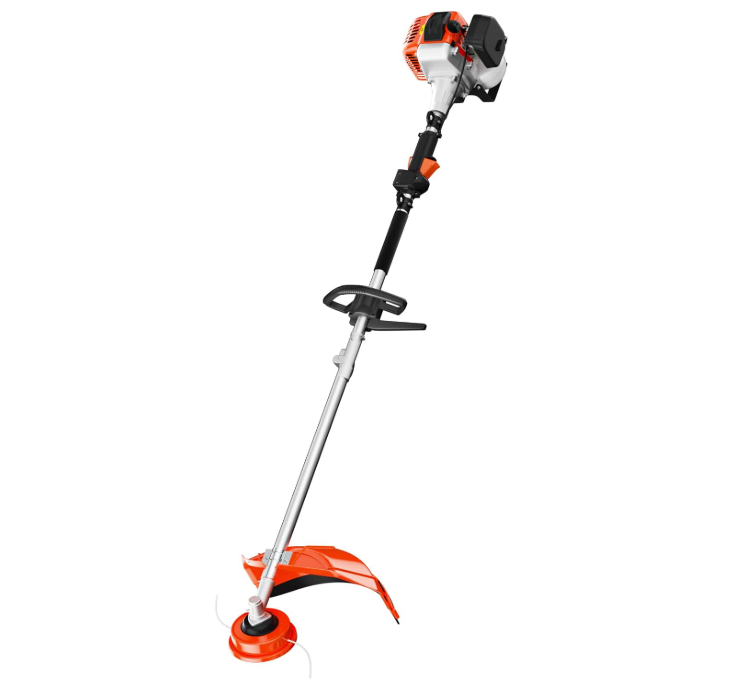
The 36cc Gas Trimmer represents traditional commercial power with modern convenience features. This versatile 3-in-1 system combines string trimming, edging, and brush cutting capabilities in a single gas-powered platform designed for demanding commercial applications. The powerful two-stroke engine delivers the torque necessary to cut through dense vegetation and woody stems.
The 36cc displacement provides substantial power for heavy-duty commercial applications while maintaining manageable weight and balance characteristics. The two-stroke engine design delivers excellent power-to-weight ratio essential for extended commercial use. Quick-start technology reduces pull-cord effort while electronic ignition ensures reliable starting in various weather conditions.
Multi-functionality distinguishes this trimmer from single-purpose models by including edging and brush cutting attachments. The quick-change head system allows operators to switch between string trimmer, edger blade, and brush cutter configurations based on task requirements. This versatility reduces equipment inventory needs for smaller commercial operations.
Professional-grade construction includes anti-vibration systems that isolate engine movement from operator handles. The straight shaft design provides excellent reach and balance for commercial applications while accommodating various operator heights. Heavy-duty gear head construction withstands the demands of continuous commercial operation.
Fuel efficiency considerations make this trimmer cost-effective for extended commercial use. The carburetor delivers optimal fuel mixture across varying load conditions while the air filtration system protects internal components from debris damage. Easy-access maintenance points simplify routine service requirements for busy commercial crews.
Specifications:
- Engine: 36cc two-stroke gas
- Features: 3-in-1 capability (trimmer/edger/brush cutter)
- Shaft: Straight design for extended reach
- Starting: Quick-start technology with electronic ignition
- Vibration Control: Anti-vibration handle system
- Attachments: Interchangeable heads for multiple functions
Pros:
- Powerful gas engine for heavy-duty applications
- Multiple attachment options
- No battery limitations or charging requirements
- Quick-start technology
- Anti-vibration system
- Cost-effective for high-usage applications
Cons:
- Requires fuel mixing and regular maintenance
- Heavier than battery alternatives
- Exhaust emissions and noise considerations
- Seasonal storage requirements
5. 20000 RPM Electric Weed Wacker: High-Performance Innovation
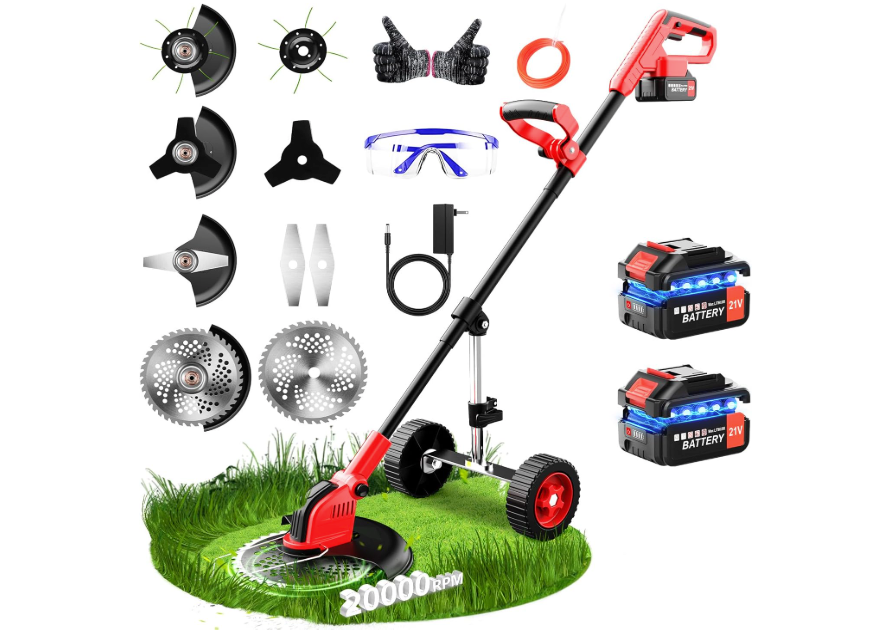
The 20000 RPM Electric Weed Wacker represents cutting-edge battery technology with exceptional motor performance designed for demanding commercial applications. The brushless motor technology delivers unprecedented speed while the 4-in-1 functionality provides versatility that matches or exceeds gas-powered alternatives. The inclusion of five blades and dual batteries makes this system ready for intensive commercial use.
The impressive 20,000 RPM motor speed generates exceptional cutting performance that rivals gas-powered alternatives while maintaining the convenience and environmental benefits of battery operation. The brushless motor design eliminates maintenance requirements while providing consistent power delivery throughout the battery discharge cycle. Variable speed control allows operators to match power output to cutting requirements.
The 4-in-1 functionality includes string trimmer, brush cutter, grass trimmer, and lawn mower modes, providing comprehensive cutting capabilities in a single tool. The quick-change attachment system allows rapid transitions between modes without tool requirements. The wheeled lawn mower mode reduces operator fatigue during extended cutting sessions on larger areas.
Dual battery design ensures extended operational capability for commercial applications while the fast-charging system minimizes downtime between work sessions. The battery management system prevents over-discharge and overheating while maximizing battery life. LED indicators provide clear battery status information for operational planning.
The five included blade set provides options for different cutting applications from fine grass maintenance to brush clearing. The stringless design eliminates string replacement requirements while delivering consistent cutting performance. The 12-inch cutting width balances productivity with maneuverability for most commercial applications.
Specifications:
- Motor: 20,000 RPM brushless electric
- Features: 4-in-1 functionality with wheeled mode
- Cutting Width: 12 inches
- Batteries: Dual battery system with fast charging
- Blades: Five-blade set included
- Design: Stringless cutting system
Pros:
- Exceptional motor speed and cutting performance
- 4-in-1 versatility reduces equipment needs
- Stringless design eliminates line replacement
- Dual battery system for extended runtime
- Brushless motor requires no maintenance
- Wheeled mode reduces operator fatigue
Cons:
- Higher initial investment than basic trimmers
- Battery dependency requires backup power packs
- Limited availability of replacement blades
- Heavier than single-function trimmers
Commercial Application Considerations
Selecting the optimal commercial grass trimmer requires careful consideration of specific operational requirements and working conditions. Property size directly impacts trimmer selection, with larger commercial properties benefiting from wider cutting swaths and extended runtime capabilities. Smaller properties may prioritize maneuverability and precision over raw cutting capacity.
Vegetation types encountered during commercial operations influence power requirements and cutting head selection. Light grass and weed maintenance suits lower-powered battery systems, while dense undergrowth and woody stems demand higher torque gas engines or high-voltage battery systems. Understanding typical vegetation challenges guides appropriate power level selection.
Crew size and equipment sharing patterns affect battery system selection for commercial operations. Large crews benefit from standardized battery platforms that allow power pack sharing across multiple operators and tool types. Smaller operations may prioritize individual tool optimization over platform standardization benefits.
Noise restrictions in commercial environments increasingly favor battery-powered equipment over gas alternatives. Many commercial properties limit operating hours for gas-powered equipment, while battery systems typically face no noise-related restrictions. Understanding client noise sensitivities guides appropriate technology selection.
Maintenance and Operating Cost Analysis
Commercial trimmer total cost of ownership extends far beyond initial purchase price. Battery-powered systems typically demand higher upfront investment but offer lower operating costs through reduced maintenance requirements and eliminated fuel costs. Gas-powered systems provide lower initial costs but require ongoing fuel, oil, and maintenance expenses.
Battery replacement costs represent the primary long-term expense for cordless commercial trimmers. Professional-grade lithium-ion batteries typically provide 2-3 years of commercial service before capacity degradation requires replacement. Planning for battery replacement costs ensures accurate long-term budgeting for commercial operations.
Gas-powered trimmer maintenance requirements include regular carburetor cleaning, spark plug replacement, air filter service, and seasonal storage preparation. Professional crews often perform this maintenance in-house, but the time investment reduces available billable hours. Commercial warranty coverage varies significantly between manufacturers and usage types.
Fuel costs for gas-powered trimmers fluctuate with petroleum prices while battery charging costs remain relatively stable. Commercial operations benefit from analyzing local fuel costs versus electricity rates to determine the most cost-effective power source for their specific operational patterns and usage volumes.
Safety Considerations for Commercial Use
Commercial grass trimmer operations require comprehensive safety protocols to protect operators and bystanders from injury. Personal protective equipment includes eye protection, hearing protection, long pants, closed-toe shoes, and gloves. Commercial crews must maintain and enforce safety equipment usage to prevent workplace injuries.
Debris projection poses significant hazards during commercial trimming operations. Operators must inspect work areas for rocks, metal objects, and other projectiles before beginning work. Client notification about potential debris hazards helps prevent property damage and maintains professional relationships.
Fuel handling and storage safety becomes critical for commercial operations using gas-powered trimmers. Proper fuel mixing ratios prevent engine damage while safe storage practices reduce fire hazards. Commercial insurance requirements may specify fuel storage and handling procedures for business operations.
Battery safety protocols include proper charging procedures, damage inspection, and disposal requirements for end-of-life batteries. Lithium-ion batteries require specific handling procedures to prevent thermal runaway conditions. Commercial operations must establish battery safety protocols to protect employees and facilities.
Technology Trends Shaping Commercial Trimmers
Smart technology integration increasingly appears in commercial grass trimmers through features like automatic string feeding, engine management systems, and diagnostic capabilities. These technologies reduce operator skill requirements while improving consistency and efficiency in commercial operations. Future developments may include GPS tracking and remote monitoring capabilities.
Battery technology continues advancing with higher energy density cells that provide longer runtime in smaller, lighter packages. Solid-state battery development promises even greater improvements in energy storage and charging speed. These advances will further expand battery-powered trimmer capabilities in commercial applications.
Electric motor efficiency improvements deliver more power per watt while extending battery runtime. Brushless motor technology eliminates maintenance requirements while providing precise speed control. Future motor developments may include integrated sensors that automatically adjust power output based on cutting load conditions.
Environmental regulations increasingly favor clean-burning or zero-emission equipment in commercial applications. Battery-powered systems completely eliminate direct emissions while newer gas engines incorporate catalytic converters and improved combustion systems. Commercial operations must consider current and future emission requirements when selecting equipment.
Buying Guide for Commercial Operations
Commercial grass trimmer procurement requires systematic evaluation of operational requirements against available equipment capabilities. Creating detailed requirement specifications helps identify the most suitable equipment for specific commercial applications. Consider factors including daily runtime requirements, typical vegetation types, operator skill levels, and client expectations.
Budget considerations extend beyond initial purchase price to include long-term operating costs, maintenance requirements, and replacement schedules. Total cost of ownership analysis provides more accurate equipment selection guidance than purchase price alone. Factor in battery replacement costs, fuel expenses, and maintenance labor when comparing alternatives.
Dealer support and parts availability significantly impact commercial equipment satisfaction. Local dealer network strength affects service response times and parts availability for critical repairs. Commercial warranty terms vary significantly between manufacturers, with some offering extended coverage for verified commercial applications.
Fleet standardization benefits include reduced training requirements, simplified maintenance procedures, and bulk purchasing opportunities. Standardizing on compatible battery platforms or similar gas engine families reduces complexity while potentially improving purchasing power with suppliers.
Professional Maintenance Best Practices
Establishing consistent maintenance routines maximizes commercial trimmer reliability and extends equipment life. Daily pre-use inspections should include safety system checks, cutting head inspection, and battery or fuel level verification. Post-use cleaning removes debris that can cause premature wear or operational problems.
Battery maintenance for commercial operations includes proper charging procedures, storage temperature control, and capacity monitoring. Avoiding complete discharge cycles and extreme temperatures extends battery life significantly. Rotating battery usage across multiple packs prevents individual battery overuse and premature capacity loss.
Gas-powered trimmer maintenance requires regular carburetor cleaning, air filter replacement, and spark plug service. Seasonal maintenance includes fuel system cleaning and proper storage preparation. Maintaining service records helps identify wear patterns and optimize maintenance schedules for maximum equipment availability.
Cutting head maintenance includes string quality selection, proper loading procedures, and wear part replacement. Using manufacturer-specified string diameter and composition ensures optimal cutting performance while preventing premature head wear. Regular cleaning removes accumulated debris that can cause line feeding problems.
Conclusion: Selecting Your Commercial Grass Trimmer
The commercial grass trimmer market continues evolving with advancing battery technology challenging traditional gas-powered dominance. Professional landscapers now have viable options across power sources and price points that can meet diverse commercial requirements. Success depends on matching specific operational needs with appropriate equipment capabilities.
Battery-powered trimmers like the EGO POWER+ ST1623T represent the technological forefront with innovative features like automatic string feeding and instant starting capability. These systems excel in noise-sensitive environments while eliminating fuel-related maintenance requirements. The higher initial investment often pays dividends through reduced operating costs and improved operator satisfaction.
Versatile systems like the Worx models provide multi-functionality that reduces equipment inventory requirements for smaller commercial operations. The 3-in-1 capabilities allow crews to handle diverse maintenance tasks with fewer tools while maintaining professional results. These systems work particularly well for detail-oriented commercial applications.
Gas-powered alternatives continue serving heavy-duty commercial applications where maximum power and unlimited runtime remain essential. The 36cc gas trimmer delivers proven performance for demanding vegetation control while providing cost-effective operation for high-usage applications. Professional crews appreciate the immediate refueling capability and unlimited operational range.
High-performance electric systems like the 20000 RPM trimmer bridge the gap between battery convenience and gas-powered performance. These innovative systems deliver cutting performance that rivals gas alternatives while maintaining battery-powered benefits. The stringless design eliminates a common maintenance requirement while providing consistent cutting results.
Commercial success with grass trimmers depends on understanding specific operational requirements and selecting equipment that optimizes productivity while controlling costs. The reviewed trimmers represent current market leaders that can serve diverse commercial applications effectively. Professional landscapers should evaluate their specific needs against these capabilities to identify the optimal equipment for their operations.
Investment in quality commercial grass trimmers pays dividends through improved productivity, reduced maintenance costs, and enhanced professional results. The rapidly advancing technology continues expanding capabilities while environmental considerations increasingly favor clean-operating alternatives. Commercial operations that stay current with equipment technology maintain competitive advantages in an evolving marketplace.
The future of commercial grass trimmers points toward continued battery technology advancement, smart feature integration, and environmental compliance improvements. Professional landscapers who understand these trends can make informed equipment decisions that position their operations for long-term success while meeting evolving client expectations and regulatory requirements.
